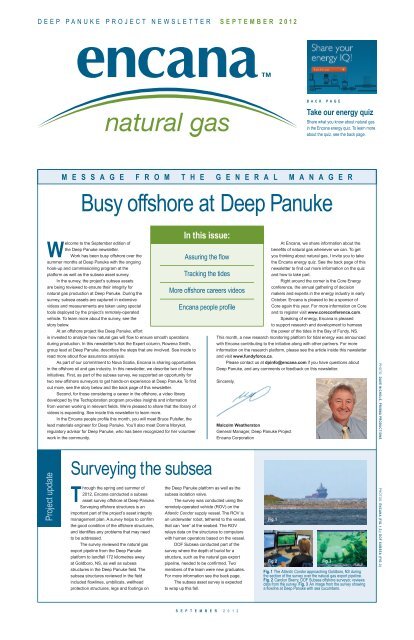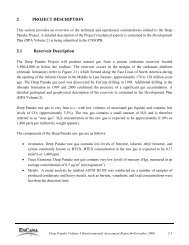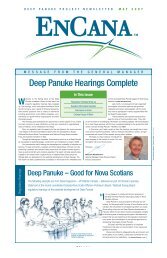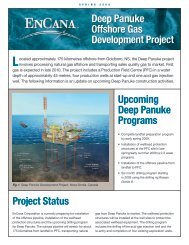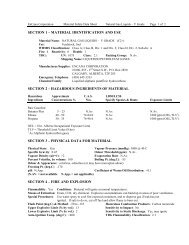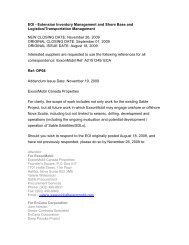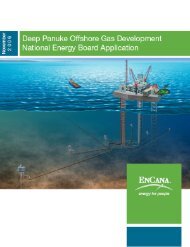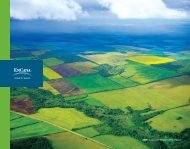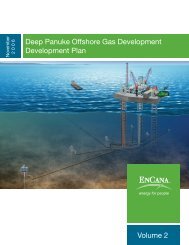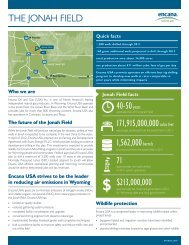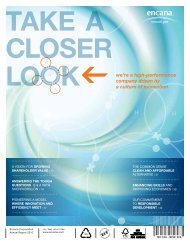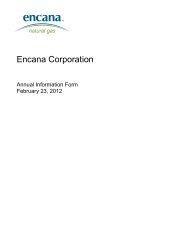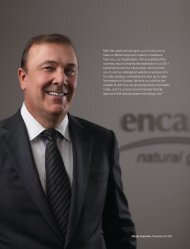Deep Panuke newsletter - Encana
Deep Panuke newsletter - Encana
Deep Panuke newsletter - Encana
You also want an ePaper? Increase the reach of your titles
YUMPU automatically turns print PDFs into web optimized ePapers that Google loves.
DEEP PANUKE PROJECT NEWSLETTER SEPTEMBER 2012<br />
B A C K P A G E<br />
Take our energy quiz<br />
Share what you know about natural gas<br />
in the <strong>Encana</strong> energy quiz. To learn more<br />
about the quiz, see the back page.<br />
M E S S A G E F R O M T H E G E N E R A L M A N A G E R<br />
Busy offshore at <strong>Deep</strong> <strong>Panuke</strong><br />
W<br />
elcome to the September edition of<br />
the <strong>Deep</strong> <strong>Panuke</strong> <strong>newsletter</strong>.<br />
Work has been busy offshore over the<br />
summer months at <strong>Deep</strong> <strong>Panuke</strong> with the ongoing<br />
hook-up and commissioning program at the<br />
platform as well as the subsea asset survey.<br />
In the survey, the project’s subsea assets<br />
are being reviewed to ensure their integrity for<br />
natural gas production at <strong>Deep</strong> <strong>Panuke</strong>. During the<br />
survey, subsea assets are captured in extensive<br />
videos and measurements are taken using special<br />
tools deployed by the project’s remotely-operated<br />
vehicle. To learn more about the survey, see the<br />
story below.<br />
At an offshore project like <strong>Deep</strong> <strong>Panuke</strong>, effort<br />
is invested to analyze how natural gas will flow to ensure smooth operations<br />
during production. In this <strong>newsletter</strong>’s Ask the Expert column, Rowena Smith,<br />
group lead at <strong>Deep</strong> <strong>Panuke</strong>, describes the steps that are involved. See inside to<br />
read more about flow assurance analysis.<br />
As part of our commitment to Nova Scotia, <strong>Encana</strong> is sharing opportunities<br />
in the offshore oil and gas industry. In this <strong>newsletter</strong>, we describe two of these<br />
initiatives. First, as part of the subsea survey, we supported an opportunity for<br />
two new offshore surveyors to get hands-on experience at <strong>Deep</strong> <strong>Panuke</strong>. To find<br />
out more, see the story below and the back page of this <strong>newsletter</strong>.<br />
Second, for those considering a career in the offshore, a video library<br />
developed by the Techsploration program provides insights and information<br />
from women working in relevant fields. We’re pleased to share that the library of<br />
videos is expanding. See inside this <strong>newsletter</strong> to learn more.<br />
In the <strong>Encana</strong> people profile this month, you will meet Bruce Pulsifer, the<br />
lead materials engineer for <strong>Deep</strong> <strong>Panuke</strong>. You’ll also meet Donna Morykot,<br />
regulatory advisor for <strong>Deep</strong> <strong>Panuke</strong>, who has been recognized for her volunteer<br />
work in the community.<br />
Project update<br />
In this issue:<br />
Assuring the flow<br />
Tracking the tides<br />
More offshore careers videos<br />
<strong>Encana</strong> people profile<br />
Surveying the subsea<br />
Through the spring and summer of<br />
2012, <strong>Encana</strong> conducted a subsea<br />
asset survey offshore at <strong>Deep</strong> <strong>Panuke</strong>.<br />
Surveying offshore structures is an<br />
important part of the project’s asset integrity<br />
management plan. A survey helps to confirm<br />
the good condition of the offshore structures,<br />
and identifies any problems that may need<br />
to be addressed.<br />
The survey reviewed the natural gas<br />
export pipeline from the <strong>Deep</strong> <strong>Panuke</strong><br />
platform to landfall 172 kilometres away<br />
at Goldboro, NS, as well as subsea<br />
structures in the <strong>Deep</strong> <strong>Panuke</strong> field. The<br />
subsea structures reviewed in the field<br />
included flowlines, umbilicals, wellhead<br />
protection structures, legs and footings on<br />
At <strong>Encana</strong>, we share information about the<br />
benefits of natural gas whenever we can. To get<br />
you thinking about natural gas, I invite you to take<br />
the <strong>Encana</strong> energy quiz. See the back page of this<br />
<strong>newsletter</strong> to find out more information on the quiz<br />
and how to take part.<br />
Right around the corner is the Core Energy<br />
conference, the annual gathering of decision<br />
makers and experts in the energy industry in early<br />
October. <strong>Encana</strong> is pleased to be a sponsor of<br />
Core again this year. For more information on Core<br />
and to register visit www.coreconference.com.<br />
Speaking of energy, <strong>Encana</strong> is pleased<br />
to support research and development to harness<br />
the power of the tides in the Bay of Fundy, NS.<br />
This month, a new research monitoring platform for tidal energy was announced<br />
with <strong>Encana</strong> contributing to the initiative along with other partners. For more<br />
information on the research platform, please see the article inside this <strong>newsletter</strong><br />
and visit www.fundyforce.ca.<br />
Please contact us at dpinfo@encana.com if you have questions about<br />
<strong>Deep</strong> <strong>Panuke</strong>, and any comments or feedback on this <strong>newsletter</strong>.<br />
Sincerely,<br />
the <strong>Deep</strong> <strong>Panuke</strong> platform as well as the<br />
subsea isolation valve.<br />
The survey was conducted using the<br />
remotely-operated vehicle (ROV) on the<br />
Atlantic Condor supply vessel. The ROV is<br />
an underwater robot, tethered to the vessel,<br />
that can “see” at the seabed. The ROV<br />
relays data on the structures to computers<br />
with human operators based on the vessel.<br />
DOF Subsea conducted part of the<br />
survey where the depth of burial for a<br />
structure, such as the natural gas export<br />
pipeline, needed to be confirmed. Two<br />
members of the team were new graduates.<br />
For more information see the back page.<br />
The subsea asset survey is expected<br />
to wrap up this fall.<br />
Malcolm Weatherston<br />
General Manager, <strong>Deep</strong> <strong>Panuke</strong> Project<br />
<strong>Encana</strong> Corporation<br />
Fig. 1<br />
Fig. 2 Fig. 3<br />
Fig. 1 The Atlantic Condor approaching Goldboro, NS during<br />
the section of the survey over the natural gas export pipeline.<br />
Fig. 2 Carolyn Skerry, DOF Subsea offshore surveyor, reviews<br />
data from the survey. Fig. 3 An image from the survey showing<br />
a flowline at <strong>Deep</strong> <strong>Panuke</strong> with sea cucumbers.<br />
PHOTO: DAVE NICHOLS, PRISMA PRODUCTIONS PHOTOS: ENCANA (FIG. 1,3); DOF SUBSEA (FIG. 2)<br />
S E P T E M B E R 2 0 1 2
D E E P P A N U K E P R O J E C T N E W S L E T T E R<br />
PHOTO: DAVE NICHOLS, PRISMA PRODUCTIONS<br />
Rowena Smith<br />
Group Lead, <strong>Deep</strong> <strong>Panuke</strong><br />
You’ve got questions.<br />
<strong>Deep</strong> <strong>Panuke</strong> experts can answer.<br />
Q. Why is flow assurance analysis important at <strong>Deep</strong> <strong>Panuke</strong>?<br />
A.<br />
Flow assurance analysis helps ensure<br />
the continuous production of natural<br />
gas at <strong>Deep</strong> <strong>Panuke</strong> (Fig. 1).<br />
Flow assurance analysis covers all aspects<br />
of the production system and includes topics<br />
such as mechanical integrity, examining the<br />
properties of fluids in the system, pressure and<br />
temperature analysis and slugging.<br />
Engineers working in flow assurance<br />
develop plans and strategies to address these<br />
topics.<br />
In the case of pressure and temperature<br />
challenges, there is a risk of hydrates forming.<br />
A hydrate forms from a combination of<br />
water and natural gas fluids when there is the<br />
right combination of pressure and temperature.<br />
A hydrate—similar to slush which can become<br />
an ice ball—can plug a flowline (Fig. 2). A hydrate<br />
can form at temperatures much higher than<br />
the 0 degrees Celsius at which ice forms. The<br />
seabed at <strong>Deep</strong> <strong>Panuke</strong>, averaging from 0 to<br />
16 degrees Celsius, is the ideal “cooling”<br />
environment for the gas in the flowlines. To<br />
prevent the formation of hydrates at <strong>Deep</strong> <strong>Panuke</strong>,<br />
methanol is injected into the flowlines during<br />
startups and shutdowns. In these transition<br />
periods, hydrates are more likely to form because<br />
the natural gas is cooler than it is during<br />
steady state production operations. To prevent<br />
hydrates from forming in the flowlines during<br />
steady state, the flowlines are insulated<br />
to retain heat (Fig. 3).<br />
A challenge related to fluid property<br />
analysis is the risk of forming scale. Scale can<br />
result in a build up of material that could plug<br />
flowlines, pipe, and other equipment. At <strong>Deep</strong><br />
<strong>Panuke</strong>, material deposition on the inside<br />
of a flowline is a flow assurance concern and<br />
scale formation is prevented by injecting a<br />
scale inhibitor.<br />
Methanol and scale inhibitors are added<br />
through the umbilicals that run alongside each<br />
flowline (Fig. 4). Each umbilical includes hollow<br />
lines designed for this purpose. The umbilicals<br />
also include the hydraulic control lines to<br />
remotely operate each production well from<br />
the platform.<br />
Slugging occurs when a large volume<br />
of liquid such as water is transported to the<br />
production platform via a flowline. When there<br />
is enough accumulation of liquid in the flowline,<br />
a “slug” is pushed through by the natural gas<br />
behind it. The two separators—the inlet and<br />
test separator—have been designed to<br />
accommodate the maximum expected slug<br />
volumes at <strong>Deep</strong> <strong>Panuke</strong>.<br />
Have a question? Contact us at dpinfo@encana.com<br />
How will natural gas be produced<br />
at <strong>Deep</strong> <strong>Panuke</strong>?<br />
At the <strong>Deep</strong> <strong>Panuke</strong> field in Nova Scotia’s offshore, four<br />
production wells will produce natural gas from the reservoir<br />
located about 3 ½ kilometres below the seabed (Fig. 5).<br />
The gas will be 80 to 105 degrees Celsius (depending<br />
on the flow rate) when it comes to surface for transportation in<br />
one of four flowlines (one for each well) to the platform. At the<br />
platform, the raw gas is treated to remove condensate, water,<br />
hydrogen sulphide and carbon dioxide.<br />
In all, there are 15 kilometres of flowlines at <strong>Deep</strong> <strong>Panuke</strong><br />
for transporting the raw gas from the wellheads to the platform.<br />
An injection line that is 1.7 kilometres long will take the hydrogen<br />
sulphide and carbon dioxide removed from the gas stream to an<br />
injection well for disposal about 2 ½ kilometres below the seabed.<br />
Market-ready gas will leave the platform, and be transported<br />
to shore in a subsea pipeline measuring 22 inches in diameter.<br />
<strong>Deep</strong> <strong>Panuke</strong> has a design capacity of 300 million standard cubic<br />
feet per day (MMscf/day) of natural gas, enough to power more<br />
than half a million homes on a daily basis.<br />
To help keep the natural gas flowing continuously from each<br />
production well, and through treatment to the subsea pipeline,<br />
key flow assurance strategies are in place—like those that are<br />
described in this section of the <strong>newsletter</strong>.<br />
WELL MONITORING LINES<br />
WELL CHEMICAL<br />
INJECTION LINES<br />
HYDRAULIC CONTROL LINES<br />
SUBSEA POWER AND<br />
COMMUNICATION LINES<br />
Fig. 1 The <strong>Deep</strong> <strong>Panuke</strong> platform, or Production Field<br />
Centre, 250 km southeast of Halifax, NS.<br />
Fig. 3 A layer of insulation approximately one<br />
inch thick is bonded to each pipe section.<br />
Fig. 4 A coiled umbilical (circled) for <strong>Deep</strong> <strong>Panuke</strong> on Subsea 7’s Acergy<br />
Discovery awaiting field installation. Inset: Cross section of an umbilical.<br />
PHOTOS AND ILLUSTRATIONS: ENCANA<br />
Fig. 2 Sections of pipe that became flowlines at <strong>Deep</strong> <strong>Panuke</strong> being prepared for shipment<br />
offshore from Sheet Harbour, NS. Inset: Once welded together, the pipe sections formed a<br />
continuous flowline. Here a <strong>Deep</strong> <strong>Panuke</strong> flowline is being installed by Subsea 7’s Acergy Falcon.<br />
Fig. 5 An illustration of the <strong>Deep</strong> <strong>Panuke</strong> field showing the platform and structures at<br />
the seabed such as the wells, flowlines and pipeline to landfall.<br />
S E P T E M B E R 2 0 1 2
D E E P P A N U K E P R O J E C T N E W S L E T T E R<br />
Research and development<br />
Tracking the tides<br />
<strong>Deep</strong> <strong>Panuke</strong> project<br />
<strong>Encana</strong> people<br />
PHOTO: ENCANA PHOTO: PROVINCE OF NOVA SCOTIA<br />
Cape Split on the Bay of Fundy, NS. The Bay of Fundy is home to the world’s highest tides.<br />
Developing tidal energy in<br />
the powerful waters of<br />
Nova Scotia’s Bay of Fundy<br />
requires innovative thinking, creative<br />
partnerships and cutting edge<br />
research and development.<br />
As part of our commitment to<br />
Nova Scotia, where <strong>Encana</strong> is the<br />
owner and operator of the <strong>Deep</strong><br />
<strong>Panuke</strong> offshore natural gas project,<br />
we are pleased to partner with the<br />
Fundy Ocean Research Center<br />
for Energy (FORCE) to support a<br />
research monitoring platform for tidal<br />
energy in the province.<br />
<strong>Encana</strong> is directing $3 million<br />
in funding to the platform by<br />
converting a zero interest loan from<br />
our Environmental Innovation Fund<br />
to a grant.<br />
The new platform will contribute<br />
to better understanding of the tides<br />
in the Bay of Fundy, which has<br />
Education and training<br />
Talking about<br />
Techsploration<br />
Earlier this year Christina Clarke (r), an <strong>Encana</strong> loss control engineer and a Techsploration<br />
program mentor, took six students from Prince Arthur Junior High School in Dartmouth, NS—<br />
a school she herself attended—on a tour of the offshore supply base that supports the <strong>Deep</strong><br />
<strong>Panuke</strong> project in Nova Scotia. Hailey Thomas (l) was one of the students. “Techsploration is<br />
a great way to expose young women to careers they might not have considered otherwise,”<br />
says Christina. “It wasn’t until after my first year of university that I even considered<br />
engineering, and I think that’s simply because I didn’t know enough about it. My hope is that<br />
making students aware of different options will help them with career decisions later on.”<br />
It’s no secret women are vastly<br />
under-represented in careers in the<br />
sciences, trades and technology—<br />
backgrounds that are key to work in<br />
the offshore oil and gas industry. But<br />
Techsploration is looking to change that.<br />
<strong>Encana</strong> has long supported<br />
Techsploration, a program in Nova<br />
been earmarked as a testing site<br />
for electricity generating underwater<br />
turbines. Bay of Fundy tides are the<br />
highest in the world. The underwater<br />
platform will be the world’s first<br />
deployed in extreme, high flow<br />
conditions like those in the Bay of<br />
Fundy. Good resource information<br />
translates into good turbine<br />
design—the platform will collect<br />
continuous data on the tides and<br />
surrounding environment and relay<br />
that information to the nearby tidal<br />
observation facility on the outskirts<br />
of Parrsboro, NS.<br />
Other partners in the exciting<br />
research include the Government of<br />
Canada, Ocean Networks Canada<br />
and the turbine developers who<br />
are working to harness the power<br />
of the tides.<br />
To learn more, visit FORCE at<br />
www.fundyforce.ca.<br />
Scotia that encourages female students<br />
in Grades 9 through 12 to explore<br />
careers in sciences, trades and<br />
technology. The Techsploration program<br />
showcases potential careers, and<br />
stresses the importance of high school<br />
math as a strong foundation for work<br />
in many technical fields. <strong>Encana</strong>’s<br />
Bruce Pulsifer, Lead Materials Engineer<br />
If you want to know what <strong>Deep</strong> <strong>Panuke</strong> is made of,<br />
talk to Bruce Pulsifer. He is the project’s lead materials<br />
engineer.<br />
In Bruce’s job, he assesses the materials<br />
used in all aspects of <strong>Deep</strong> <strong>Panuke</strong>—from perfs to<br />
processing to point-of-sale.<br />
One example of Bruce’s work was helping to<br />
determine what the project’s flowlines needed to be<br />
made from. There are four production flowlines at<br />
<strong>Deep</strong> <strong>Panuke</strong>, each transporting natural gas from a<br />
well to the offshore platform for treatment.<br />
Because the natural gas at <strong>Deep</strong> <strong>Panuke</strong> is<br />
under pressure and sour (meaning that it contains hydrogen sulphide), extra care was needed<br />
to prevent cracking and corrosion by selecting the right materials to build the flowlines. The<br />
solution: flowlines made with Incoloy 825 cladding, a corrosion resistant alloy.<br />
Bruce hails from Middle Musquodoboit, NS where he lived briefly on a dairy farm before<br />
moving to Dartmouth. He is a graduate of the engineering school at Dalhousie University,<br />
receiving his Bachelor and Master degrees in metallurgical engineering—the study of metals<br />
and alloys and how they can be used reliably and economically in industrial applications.<br />
As an Accredited Materials Selection Specialist with the National Association of Corrosion<br />
Engineers, Bruce combines extensive experience with his unique training in applying the<br />
principles of materials selection.<br />
Following graduation from engineering school, Bruce worked in the oil and gas industry<br />
onshore in Western Canada for about a decade. He has worked in the offshore oil and gas<br />
industry for more than 20 years, with experience on projects in Indonesia and the Persian Gulf.<br />
In 2006, he jumped at the chance to work on the <strong>Deep</strong> <strong>Panuke</strong> project. “A great group<br />
of diverse professionals has been assembled for the <strong>Deep</strong> <strong>Panuke</strong> team,” says Bruce. “I’m<br />
pleased to contribute to the team.”<br />
For those considering a career in the offshore oil and gas industry, Bruce offers the<br />
following advice: “On an offshore project like <strong>Deep</strong> <strong>Panuke</strong>, contributing and learning are the most<br />
gratifying aspects. And any day when you can learn something new, then that’s a good day!”<br />
Engineering at <strong>Encana</strong> is a natural fit for the Pulsifer family. Bruce’s son works as an<br />
engineer at the <strong>Encana</strong> head office in Calgary, Alberta.<br />
Bruce and family are planning another rendezvous “down south” later this year. Having<br />
spent more than a dozen winters in sunny climates, it’s a tradition that’s easy to warm up to!<br />
Bruce Pulsifer at the <strong>Deep</strong> <strong>Panuke</strong> pipeyard, Sheet Harbour, NS. These sections of pipe<br />
became flowlines at <strong>Deep</strong> <strong>Panuke</strong> that will transport natural gas from the wells to the<br />
production platform.<br />
support for Techsploration has<br />
included financial contributions,<br />
volunteer mentoring and in-kind<br />
donations.<br />
In 2009 <strong>Encana</strong> stepped up<br />
support for Techsploration by<br />
funding the development of the<br />
Women in Action web video series.<br />
These testimonial videos feature<br />
women in careers typically underrepresented<br />
by women, from power<br />
engineering to pipefitting. <strong>Encana</strong><br />
engineer and former Techsploration<br />
mentor Cindy MacDonnell is one<br />
of the 28 women currently profiled<br />
in the series.<br />
But there is more on the<br />
way. Expanded funding from<br />
<strong>Encana</strong> will see nine new videos<br />
added—three per year for the<br />
next three years. The new videos<br />
focus on offshore-related careers.<br />
To start, videos of a tugboat captain,<br />
an offshore surveyor and a helicopter<br />
mechanic will be added to the<br />
series in 2012.<br />
The videos have received<br />
more than 38,000 hits from around<br />
the world, and are being picked<br />
up in classrooms across Canada.<br />
The Nova Scotia Department of<br />
Labour and Advanced Education has<br />
asked to include the videos in their<br />
occupational profiles on the<br />
careers.novascotia.ca website.<br />
The videos can be viewed via<br />
Techsploration’s YouTube channel at<br />
www.youtube.com/techsploration<br />
or the Techsploration website at<br />
www.techsploration.ca.<br />
PHOTOS: DAVE NICHOLS, PRISMA PRODUCTIONS<br />
S E P T E M B E R 2 0 1 2
D E E P P A N U K E P R O J E C T N E W S L E T T E R<br />
Subsea asset survey<br />
All aboard with new offshore surveyors<br />
To give offshore surveying graduates<br />
key field experience, <strong>Encana</strong> supported<br />
a new initiative in 2012 during the<br />
subsea asset survey at <strong>Deep</strong> <strong>Panuke</strong>.<br />
In the initiative, Carolyn Skerry and<br />
John-Gavin Dunphy, two recent Nova Scotian<br />
graduates from the Centre of Geographic<br />
Sciences (COGS), participated in the<br />
offshore segment of the survey conducted<br />
by DOF Subsea.<br />
Both graduated with a Diploma in<br />
Marine Geomatics from COGS, part of the<br />
Nova Scotia Community College (NSCC—<br />
Annapolis Valley campus) in Lawrencetown,<br />
NS in the spring of 2012, and are employed<br />
by DOF Subsea as offshore surveyors.<br />
Typically hands-on experience offshore<br />
is difficult to obtain for new graduates due to<br />
the high cost and limited space onboard the<br />
vessels conducting this type of survey work<br />
for oil and gas companies.<br />
<strong>Encana</strong> provided the funding for<br />
their participation from the <strong>Deep</strong> <strong>Panuke</strong><br />
Education & Training and Research &<br />
Development Fund. Their work included<br />
mobilizing survey equipment to the remotelyoperated<br />
vehicle (ROV) on the Atlantic<br />
Condor supply vessel as well as the<br />
John-Gavin Dunphy, offshore surveyor with DOF<br />
Subsea, testing the ROVNAV used to accurately<br />
position the ROV underwater.<br />
collection and analysis of data to onboard<br />
computers from the ROV as it completed the<br />
subsea survey.<br />
Both surveyors also completed offshore<br />
survival and other relevant safety training.<br />
“I learned so much in the offshore<br />
survival and safety training—using the<br />
fire extinguishers, learning CPR and the<br />
helicopter exercises—it all definitely helped<br />
to prepare me for the work ahead,” says<br />
John-Gavin.<br />
The knowledge gained by the surveyors<br />
can be transferred to other projects in Nova<br />
Scotia’s offshore as the local oil and gas<br />
industry continues to develop.<br />
Carolyn Skerry is at home at sea. Her great-grandmother Jean<br />
Grace Tobin was born on Sable Island, NS. From a family of ten<br />
children, Jean Grace was nicknamed “Grassy”, after the grass found<br />
growing on the Island. At Christmas time, Carolyn’s family still eats<br />
from the platters and china that Grassy found washed up on the<br />
Island’s beaches. One of Carolyn’s great-great-great grandfathers<br />
was a midshipman during the Napoleonic Wars, and the family still<br />
has his commission papers signed by Napoleon himself. Carolyn’s<br />
surname Skerry is passed down from John Skerry, who set up the<br />
first ferry service across Halifax Harbour from Halifax to Dartmouth,<br />
NS, with a crew of two men working the oars. “Skipper Skerry” could<br />
get you across the harbour in thirty to forty minutes. Says Carolyn<br />
of her decision to become an offshore surveyor: “I love being on the<br />
water and it is amazing to have the chance to survey and see marine<br />
life where no one has ever been. Some projects that DOF Subsea<br />
is involved in are at depths of more than 3,000 metres!”<br />
PHOTOS: DOF SUBSEA<br />
PHOTO: ENCANA<br />
Citizen engineer<br />
Donna Morykot, regulatory advisor at <strong>Deep</strong> <strong>Panuke</strong>, is the<br />
recipient of the Engineers Nova Scotia 2012 Citizenship<br />
Award. Donna received the award, which recognizes<br />
volunteer contributions to the community made by a Professional<br />
Engineer in Nova Scotia, at the Engineers Nova Scotia annual<br />
general meeting on September 14.<br />
In her role as a member of the <strong>Deep</strong> <strong>Panuke</strong> team, Donna<br />
works closely with the Canada-Nova Scotia Offshore Petroleum<br />
Board and the National Energy Board to ensure that the project<br />
complies with regulatory requirements. As a community volunteer,<br />
she is the president of Adsum House for Women and Children<br />
and is a member of the Research Advisory Committee for Carbon Capture Storage Nova<br />
Scotia (CCSNS).<br />
Her volunteer work with Adsum has helped to break down barriers related to housing for low<br />
income women in Nova Scotia. Adsum is a recognized community leader devoted to reducing<br />
homelessness and promoting independent living for women, children and youth. Donna started<br />
volunteering for Adsum about a decade ago, serving first as a member of the Property Committee.<br />
She is now entering her second year as President of the Board of Directors.<br />
As a member of the Research Advisory Committee for CCSNS, she provides advice on<br />
the studies being conducted to consider the development of carbon capture in Nova Scotia,<br />
including onshore/offshore assessments of storage, transportation, regulatory and environmental<br />
considerations.<br />
Donna received her Bachelor of Engineering (Civil) at the Technical University of Nova<br />
Scotia (TUNS) in 1991, and in 2000 completed her Master of Engineering at TUNS—now part of<br />
Dalhousie University. Congratulations Donna!<br />
Share your energy<br />
IQ–take the quiz!<br />
To learn more about natural gas, take <strong>Encana</strong>’s energy<br />
quiz. Since the launch of the quiz earlier this year,<br />
more than 3,500 people have completed it. The 10<br />
questions in the quiz walk participants through helpful facts<br />
about the merits of natural gas, explaining why the fuel is<br />
cleaner, abundant and affordable. The quiz is among the most<br />
visited pages on the <strong>Encana</strong> website. You can take the quiz<br />
and access more information on natural gas and its versatile<br />
uses at www.encana.com/natural-gas/.<br />
F O R M O R E I N F O R M A T I O N<br />
Contact <strong>Encana</strong> in Halifax for more information on the<br />
<strong>Deep</strong> <strong>Panuke</strong> project and other <strong>Encana</strong> activities:<br />
Phone: (902) 422-4500<br />
Fax: (902) 425-2766<br />
E-mail: dpinfo@encana.com<br />
Web: www.encana.com/deeppanuke<br />
Mail: Suite 700, Founders Square, 1701 Hollis Street,<br />
Halifax, Nova Scotia B3J 3M8<br />
For information on the company responsible for the<br />
provision of the production field centre at <strong>Deep</strong> <strong>Panuke</strong>,<br />
visit www.sbmoffshore.com or contact:<br />
Oivind Tangen, Unit Manager, SBM Nova Scotia Contractors Inc.<br />
250 Baker Drive, Unit 222, Dartmouth, NS, B2W 6L4, Canada<br />
Phone: (902) 406-8700<br />
Fax: (902) 406-8722<br />
E-mail: oivind.tangen@sbmoffshore.com<br />
Follow us on<br />
twitter.com/encanacorp<br />
Like us on<br />
facebook.com/encana<br />
Watch us on<br />
youtube.com/encana<br />
If you are interested in working on the <strong>Deep</strong> <strong>Panuke</strong> project<br />
or other opportunities with <strong>Encana</strong>, watch for postings under the<br />
Work for Us section at www.encana.com.<br />
Business opportunities with SBM in Nova Scotia are now<br />
available for viewing on the <strong>Encana</strong> website at www.encana.<br />
com/communities/canada/atlantic/business-opportunities/.<br />
For information on contracting with <strong>Encana</strong> elsewhere across<br />
our operations, please visit www.encana.com.<br />
For industry information, please visit The Maritimes Energy<br />
Association at www.maritimesenergy.ca.<br />
This <strong>newsletter</strong> is printed on 100% chlorine free and acid free paper that is manufactured using pulp certified by the Forest Stewardship Council (FSC).<br />
S E P T E M B E R 2 0 1 2


